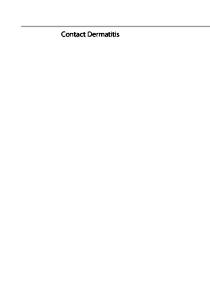Contact Allergy to Fragrances
Fragrances are used in many types of products. They are composed of 10–300 individual fragrance ingredients, many of which may be allergens. Fragrance allergy is frequent, also in adolescents. In this chapter, an overview is given of the epidemiology of f
- PDF / 49,211,037 Bytes
- 1,514 Pages / 504.63 x 737.01 pts Page_size
- 82 Downloads / 348 Views
Contact Dermatitis Sixth Edition
Contact Dermatitis
Jeanne Duus Johansen • Vera Mahler Jean-Pierre Lepoittevin • Peter J. Frosch Editors
Contact Dermatitis Sixth Edition
With 350 Figures and 271 Tables
Editors Jeanne Duus Johansen Department of Dermatology and Allergy National Allergy Research Centre Herlev and Gentofte Hospital University of Copenhagen Hellerup, Denmark Jean-Pierre Lepoittevin Laboratoire de Dermatochimie University of Strasbourg Strasbourg, France
Vera Mahler Division of Allergology Paul-Ehrlich-Institut Langen, Germany
Peter J. Frosch Professor emeritus Formerly Department of Dermatology Klinikum Dortmund Dortmund, Germany University of Witten/Herdecke Witten, Germany
ISBN 978-3-030-36334-5 ISBN 978-3-030-36335-2 (eBook) ISBN 978-3-030-36336-9 (print and electronic bundle) https://doi.org/10.1007/978-3-030-36335-2 1st to 5th edition: © Springer-Verlag Berlin Heidelberg 1992, 1995, 2001, 2006, 2011 6th edition: © Springer Nature Switzerland AG 2021 This work is subject to copyright. All rights are reserved by the Publisher, whether the whole or part of the material is concerned, specifically the rights of translation, reprinting, reuse of illustrations, recitation, broadcasting, reproduction on microfilms or in any other physical way, and transmission or information storage and retrieval, electronic adaptation, computer software, or by similar or dissimilar methodology now known or hereafter developed. The use of general descriptive names, registered names, trademarks, service marks, etc. in this publication does not imply, even in the absence of a specific statement, that such names are exempt from the relevant protective laws and regulations and therefore free for general use. The publisher, the authors, and the editors are safe to assume that the advice and information in this book are believed to be true and accurate at the date of publication. Neither the publisher nor the authors or the editors give a warranty, expressed or implied, with respect to the material contained herein or for any errors or omissions that may have been made. The publisher remains neutral with regard to jurisdictional claims in published maps and institutional affiliations. This Springer imprint is published by the registered company Springer Nature Switzerland AG. The registered company address is: Gewerbestrasse 11, 6330 Cham, Switzerland
Preface to the Current Edition
This sixth edition of the book Contact Dermatitis represents the extensive development of new knowledge in this field. Contact dermatitis is a frequent and often disabling disease, prognosis depends on up-to-date diagnostics, treatment, and prevention. The book is covering all conceivable aspects of diagnosis and modern management of contact dermatitis: irritant, allergic, and rarer forms such as photoallergic and phototoxic reactions, protein contact dermatitis, as well as immediate contact reactions. A considerable challenge is to select correct allergens for patch testing and interpret results; a range of chapters is addressing technical











